Mitigating Soil Phosphorus Leaching Risk and Improving Pear Production Through Planting and Mowing Ryegrass Mode
Abstract
1. Introduction
2. Materials and Methods
2.1. Study Area and Experimental Design
2.2. Soil Sampling and Analysis
2.3. Plant Sampling and Pear Production Indicator Analysis
2.4. Statistical Analysis
3. Results
3.1. Pear Growth and Production of Different Treatment
3.2. Soil Properties and Growth Indicator Change of Different Treatment
3.3. Soil P Leaching Risk of Different Treatments
3.4. Relationship Between Soil Properties, P Leaching Risk Indicators, and Pear Production at Different Depths
4. Discussion
4.1. Effect of Planting and Mowing Ryegrass on Soil Nutrition and P Fraction
4.2. Effect of Different Treatment on Soil P Leaching Risk
4.3. Crop Production Changes with Planting and Mowing Ryegrass
5. Conclusions
Supplementary Materials
Author Contributions
Funding
Data Availability Statement
Conflicts of Interest
References
- Wang, M.; Ma, L.; Strokal, M.; Chu, Y.; Kroeze, C. Exploring nutrient management options to increase nitrogen and phosphorus use efficiencies in food production of China. Agric. Syst. 2018, 163, 58–72. [Google Scholar] [CrossRef]
- Wang, H.; Tang, S.; Han, S.; Li, M.; Cheng, W.L.; Bu, R.Y.; Cao, W.D.; Wu, J. Effects of long-term substitution of chemical fertilizer with Chinese milk vetch on soil phosphorus availability and leaching risk in the double rice systems of Eastern China. Field Crops Res. 2023, 302, 109047. [Google Scholar] [CrossRef]
- Tao, L.; Wen, X.C.; Li, H.; Huang, C.Q.; Jiang, Y.J.; Liu, D.; Sun, B. Influence of manure fertilization on soil phosphorous retention and clay mineral transfractionation: Evidence from a 16-year long-term fertilization experiment. Appl. Clay Sci. 2021, 204, 106021. [Google Scholar] [CrossRef]
- Yang, X.Y.; Chen, X.W.; Yang, X.T. Effect of organic matter on phosphorus adsorption and desorption in a black soil from Northeast China. Soil Till. Res. 2019, 187, 85–91. [Google Scholar] [CrossRef]
- Fu, H.R.; Ma, Z.B.; Wang, X.J.; Chen, K.J.; Han, K.F.; Ma, Q.X.; Wu, L.H. Sustainable strategies related to soil fertility, economic benefit, and environmental impact on pear orchards at the farmer scale in the Yangtze River Basin, China. Environ. Sci. Pollut. Res. 2022, 30, 17316–17326. [Google Scholar] [CrossRef]
- Chen, H.; Chen, M.L.; Lia, D.J.; Mao, Q.G.; Zhang, W.; Mo, J.M. Responses of soil phosphorus availability to nitrogen addition in a legume and a non-legume plantation. Geoderma 2018, 322, 12–18. [Google Scholar] [CrossRef]
- Mahmood, M.; Tian, Y.; Ma, Q.; Hui, X.; Elrys, A.S.; Ahmed, W.; Mahmood, S.; Wang, Z. Changes in phosphorus fractions in response to long-term nitrogen fertilization in loess plateau of China. Field Crops Res. 2021, 270, 108207. [Google Scholar] [CrossRef]
- Niederberger, J.; Kohler, M.; Bauhus, J. Distribution of phosphorus fractions with different plant availability in German forest soils and their relationship with common soil properties and foliar P contents. Soil 2019, 5, 189–204. [Google Scholar] [CrossRef]
- Gao, X.; Shi, D.; Lv, A.; Wang, S.; Yuan, S.; Zhou, P.; An, Y. Increase phosphorus availability from the use of alfalfa (Medicago sativa L) green manure in rice (Oryza sativa L.) agroecosystem. Sci. Rep. 2016, 6, 36981. [Google Scholar] [CrossRef]
- Haynes, R.; Mokolobate, M. Amelioration of Al toxicity and P deficiency in acid soils by additions of organic residues: A critical review of the phenomenon and the mechanisms involved. Nutr. Cycl. Agroecosyst. 2001, 59, 47–63. [Google Scholar] [CrossRef]
- Requejo, M.I.; Eichler-Löbermann, B. Organic and inorganic phosphorus fractions in soil as affected by long-term application of organic amendments. Nutr. Cycl. Agroecosyst. 2014, 100, 245–255. [Google Scholar] [CrossRef]
- Azeez, J.O.; Van Averbeke, W. Effect of manure types and period of incubation on phosphorus-sorption indices of a weathered tropical soil. Commun. Soil Sci. Plant Anal. 2011, 42, 2200–2218. [Google Scholar] [CrossRef]
- Srivastava, A.K.; Huchche, A.D.; Ram, L.; Singh, S. Yield prediction in intercropped versus monocropped citrus orchards. Sci. Hortic. 2007, 114, 67–70. [Google Scholar] [CrossRef]
- Bai, G.S.; Zheng, S.L.; Zou, C.Y.; Du, S.N. Influence of Interplant Herbage on Soil Moisture and Apple Tree Growth in Dry Plateau of Eastern Gansu. Acta Agrestia Sin. 2018, 26, 173–183. [Google Scholar]
- Heckrath, G.; Brookes, P.C.; Poulton, P.R.; Goulding, K.W.T. Phosphorus leaching from soils containing different phosphorus concentrations in the Broadbalk experiment. J. Environ. Qual. 1995, 24, 904–910. [Google Scholar] [CrossRef]
- Hesketh, N.; Brookes, P.C. Development of an indicator for risk of phosphorus leaching. J. Environ. Qual. 2000, 29, 105–110. [Google Scholar] [CrossRef]
- Hua, K.K.; Zhang, W.J.; Guo, Z.B.; Wang, D.Z.; Oenema, O. Evaluating crop response and environmental impact of the accumulation of phosphorus due to longterm manuring of vertisol soil in northern China. Agric. Ecosyst. Environ. 2016, 219, 101–110. [Google Scholar] [CrossRef]
- Li, H.; Huang, G.; Meng, Q.; Ma, L.; Yuan, L.; Wang, F.; Zhang, W.; Cui, Z.; Shen, J.; Chen, X.; et al. Integrated soil and plant phosphorus management for crop and environment in China. A review. Plant Soil 2011, 349, 157–167. [Google Scholar] [CrossRef]
- Zhang, Q. A preliminary observation on the vertical distribution of the roots of pear trees. J. Tarim Agric. Univ. 1997, 1, 54–556. [Google Scholar]
- Bao, S.D. Soil and Agricultural Chemistry Analysis; Agriculture Publication: Beijing, China, 2000; pp. 355–356. [Google Scholar]
- Hedley, M.J.; Stewart, J.W.B.; Chauhan, B.S. Changes in inorganic and organic soil phosphorus fractions induced by cultivation practices and by laboratory incubations. Soil Sci. Soc. Am. J. 1982, 46, 970–976. [Google Scholar] [CrossRef]
- Sui, Y.; Thompson, M.L.; Shang, C. Fractionation of soil phosphorus in a Mollisol amended with biosolids. Soil Sci. Soc. Am. J. 1999, 63, 1174–1180. [Google Scholar] [CrossRef]
- Fu, H.R.; Chen, H.; Ma, Q.X.; Han, K.G.; Wu, S.F.; Wu, L.H. Effect of planting and mowing cover crops as livestock feed on soil quality and pear production. Front. Plant Sci. 2023, 13, 1105308. [Google Scholar] [CrossRef] [PubMed]
- Jensen, J.L.; Eriksen, J.; Thomsen, I.K.; Munkholm, L.J.; Christensen, B.T. Cereal straw incorporation and ryegrass cover crops: The path to equilibrium in soil carbon storage is short. Eur. J. Soil Sci. 2022, 73, e13173. [Google Scholar] [CrossRef]
- Schmidt, J.P.; Buol, S.W.; Kamprath, E.J. Soil phosphorus dynamics during seventeen years of continuous cultivation: Fractionation analyses. Soil Sci. Soc. Am. J. 1996, 60, 1168–1172. [Google Scholar] [CrossRef]
- Cross, A.F.; Schlesinger, W.H. A literature review and evaluation of the Hedley fractionation: Applications to the biogeochemical cycle of soil phosphorus in natural ecosystems. Geoderma 1995, 64, 197–214. [Google Scholar] [CrossRef]
- Shen, J.B.; Yuan, L.X.; Zhang, J.L.; Li, H.G.; Bai, Z.H.; Chen, X.P.; Zhang, W.F.; Zhang, F.S. Phosphorus dynamics: From soil to plant. Plant Physiol. 2011, 156, 997–1005. [Google Scholar] [CrossRef]
- Joan, R.; Blanco-Moreno, J.M.; Sans Francesc, X. Phosphorus mobilization in lowP arable soils may involve soil organic C depletion. Soil Biol. Biochem. 2017, 113, 250–259. [Google Scholar]
- Hou, E.; Luo, Y.; Kuang, Y.; Chen, C.R.; Lu, X.K.; Jiang, L.F.; Luo, X.Z.; Wen, D.Z. Global meta-analysis shows pervasive phosphorus limitation of aboveground plant production in natural terrestrial ecosystems. Nat. Commun. 2020, 11, 637. [Google Scholar] [CrossRef]
- Khan, A.; Jin, X.; Yang, X.; Guo, S.; Zhang, S. Phosphorus Fractions Affected by Land Use Changes in Soil Profile on the Loess Soil. J. Soil Sci. Plant Nutr. 2021, 21, 722–732. [Google Scholar] [CrossRef]
- Srivastava, R.; Basu, S.; Kumar, R. Phosphorus starvation response dynamics and management in plants for sustainable agriculture. J. Plant Biochem. Biotechnol. 2021, 30, 829–847. [Google Scholar] [CrossRef]
- Kokulan, V.; Ige, D.; Akinremi, O.O. Agri-environmental implications of N- and P-based manure application to perennial and annual cropping systems. Nutr. Cycl. Agroecosyst. 2022, 122, 205–218. [Google Scholar] [CrossRef]
- Bai, Z.H.; Li, H.G.; Yang, X.Y.; Zhou, B.K.; Shi, X.J.; Wang, B.R.; Li, D.C.; Shen, J.B.; Chen, Q.; Qin, W.; et al. The critical soil P levels for crop yield, soil fertility and environmental safety in different soil types. Plant Soil 2013, 372, 27–37. [Google Scholar] [CrossRef]
- Johnston, A.E.; Poulton, P.R.; White, R.P. Plant-available soil phosphorus. Part two: He response of arable crops to Olsen O on a sandy clay loam and a silty clay loam. Soil Use Manag. 2012, 29, 12–21. [Google Scholar] [CrossRef]
- Fu, H.R.; Chen, H.; Ma, Q.X.; Chen, B.; Wang, F.Y.; Wu, L.H. Planting and mowing cover crops as livestock feed to synergistically optimize soil properties, economic profit, and environmental burden on pear orchards in the Yangtze River Basin. J. Sci. Food Agric. 2023, 103, 6680–6688. [Google Scholar] [CrossRef]
- Fang, L.F.; Shi, X.J.; Zhang, Y.; Yang, Y.H.; Zhang, X.L.; Wang, X.Z. The effects of ground cover management on fruit yield and quality: A meta-analysis. Arch. Agron. Soil Sci. 2021, 40, 1937607. [Google Scholar] [CrossRef]
- Garcia, L.; Celette, F.; Gary, C.; Ripoche, A.; Hector, V.G.; Metay, A. Management of service crops for the provision of ecosystem services in vineyards: A review. Agric. Ecosyst. Environ. 2018, 251, 158–170. [Google Scholar] [CrossRef]
- Wei, H.; Xiang, Y.Z.; Liu, Y.; Zhang, J.E. Effects of sod cultivation on soil nutrients in orchards across China: A meta-analysis. Soil Tillage Res. 2017, 169, 16–24. [Google Scholar] [CrossRef]
- Fu, H.R.; Ma, Q.X.; Ma, Z.B.; Hu, Y.Z.; Liu, F.; Chen, K.J. Quantifying key internal and external yield-limiting factors for Chinese pear in smallholder dominant areas. HortScience 2021, 56, 1395–1401. [Google Scholar] [CrossRef]
- Chen, X.; Yan, X.; Wang, M.; Cai, Y.; Weng, X.; Su, D.; Guo, J.; Wang, W.; Hou, Y.; Ye, D.; et al. Long-term excessive phosphorus fertilization alters soil phosphorus fractions in the acidic soil of pomelo orchards. Soil Res. 2022, 215, 105214. [Google Scholar] [CrossRef]
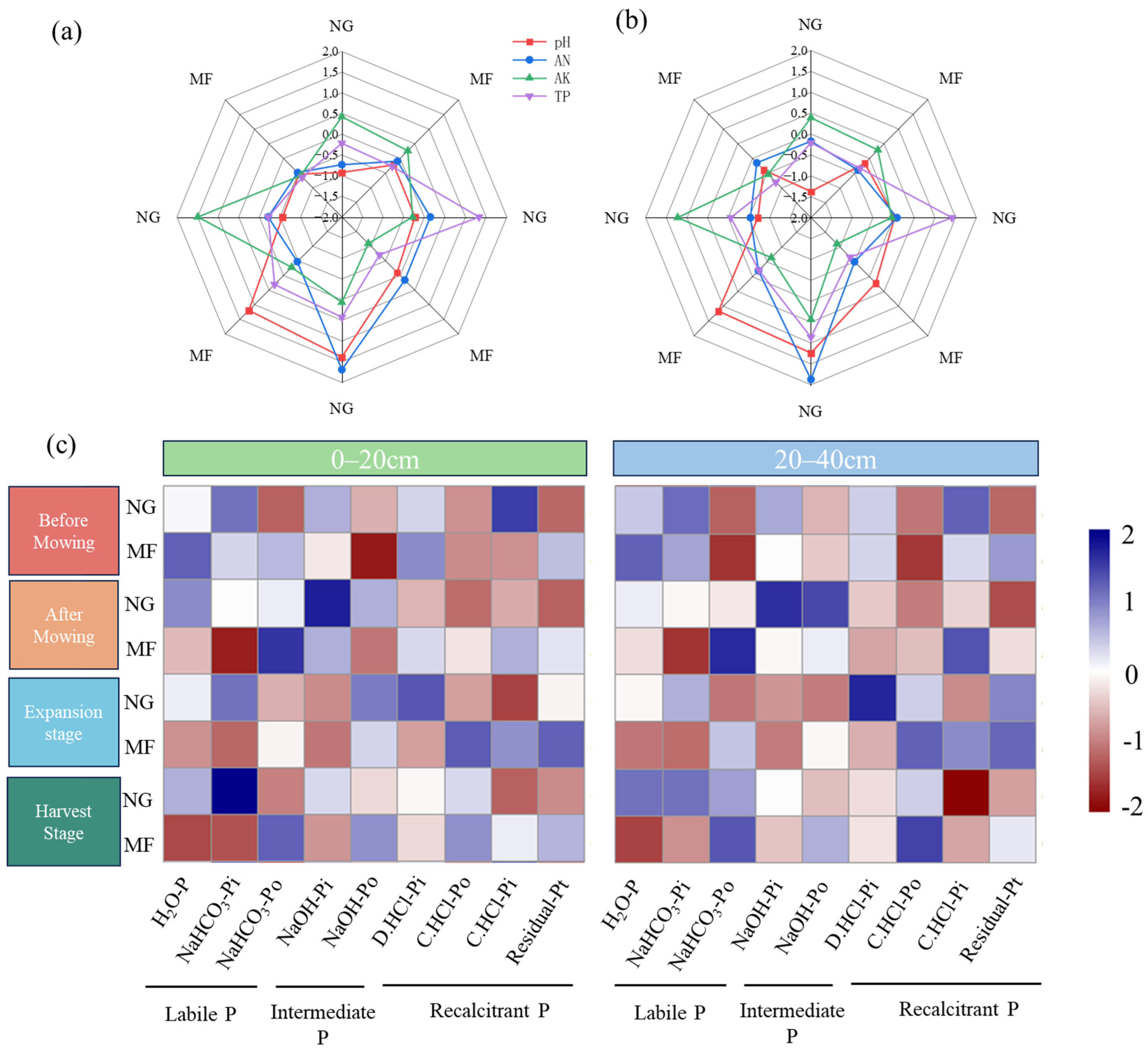
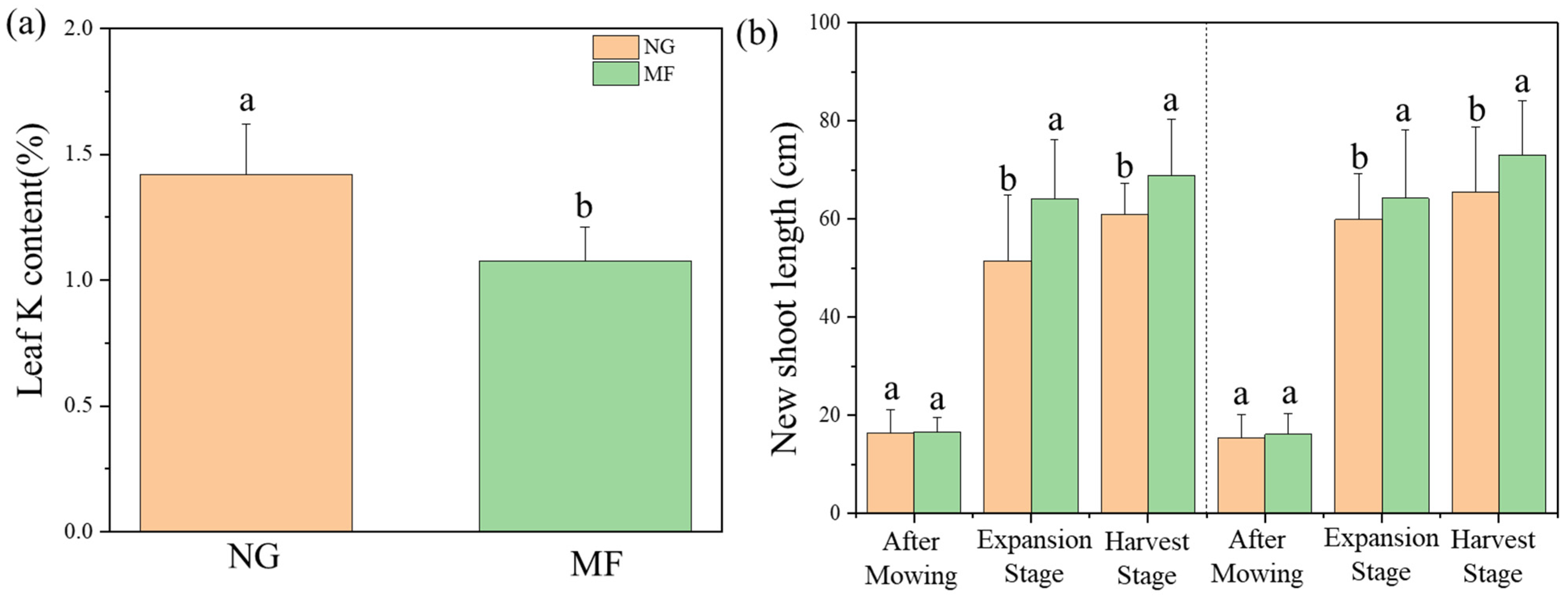
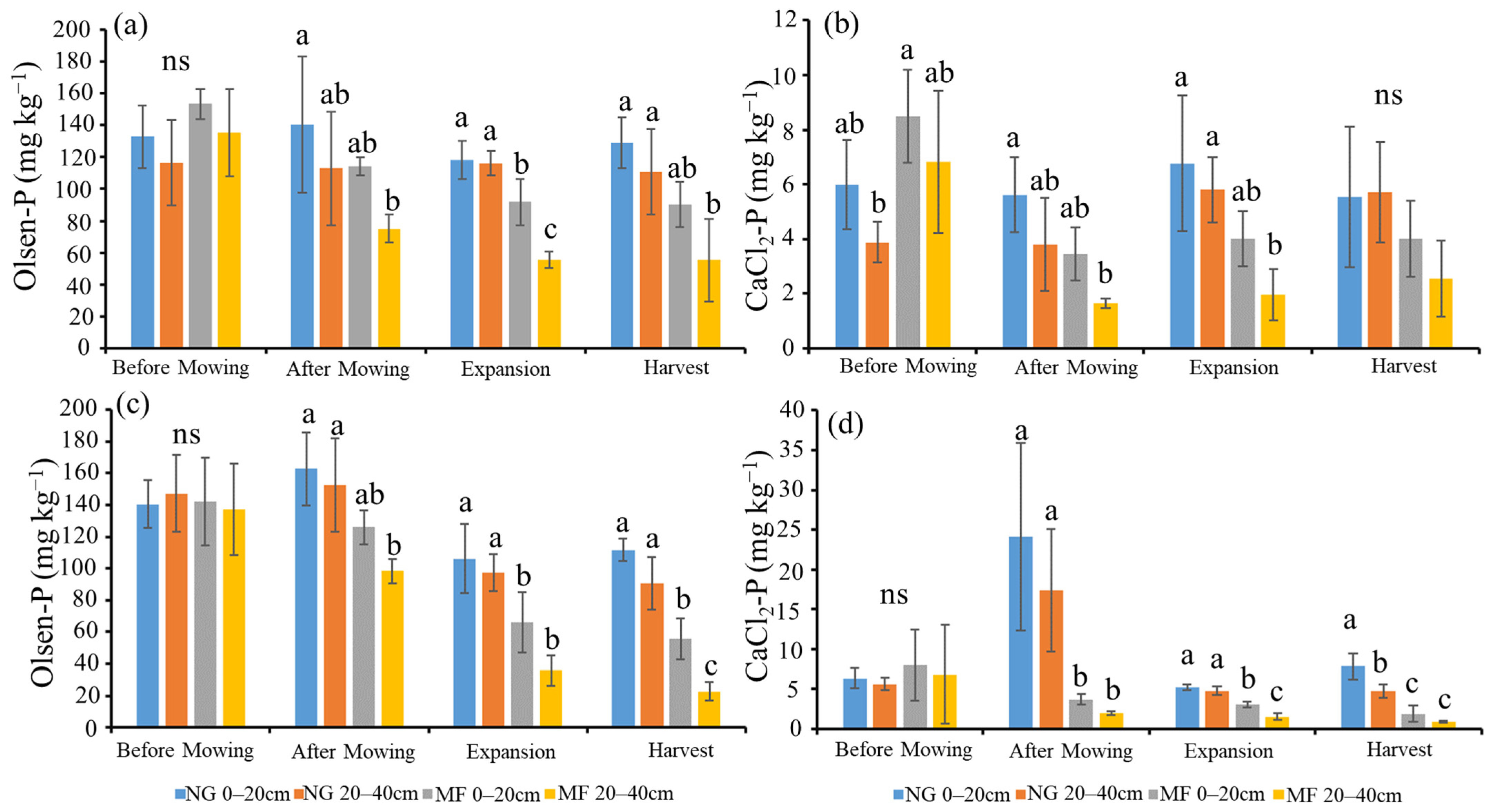
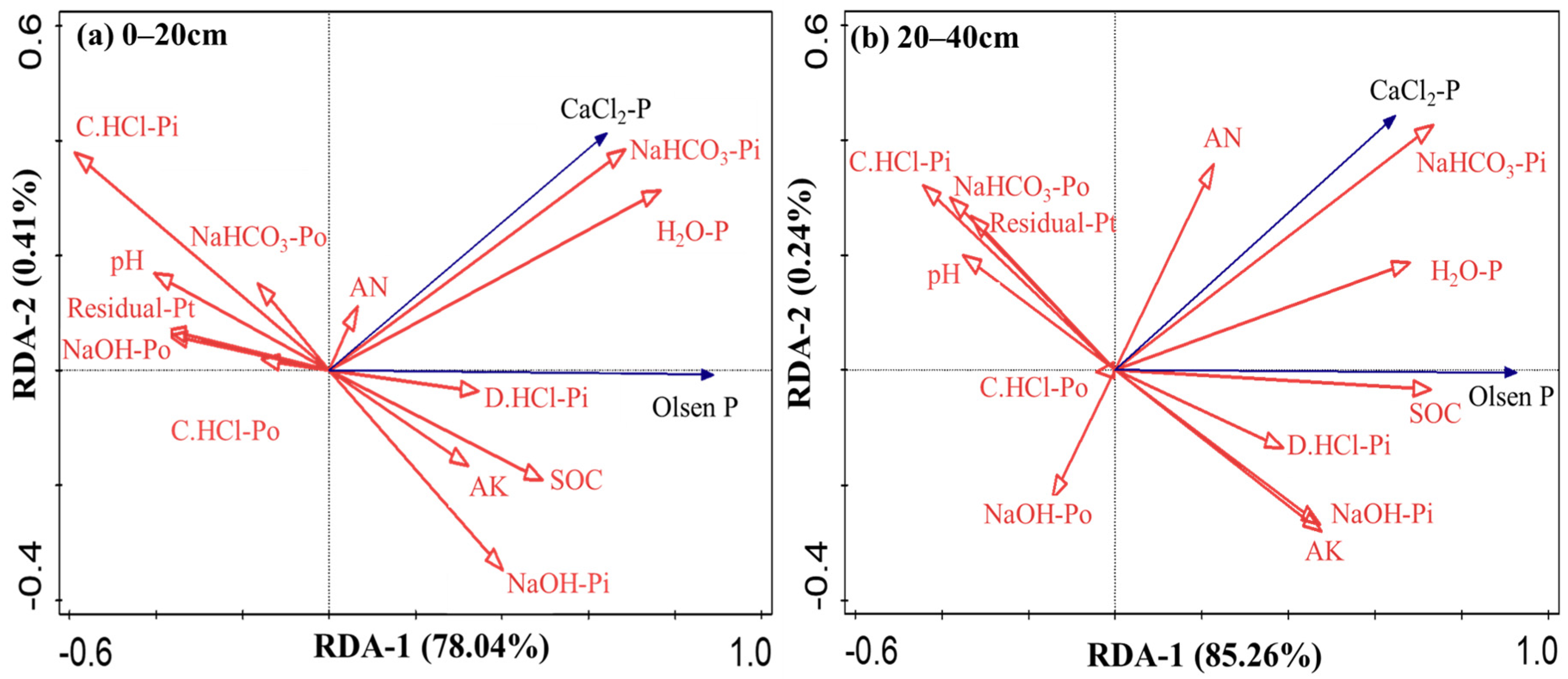

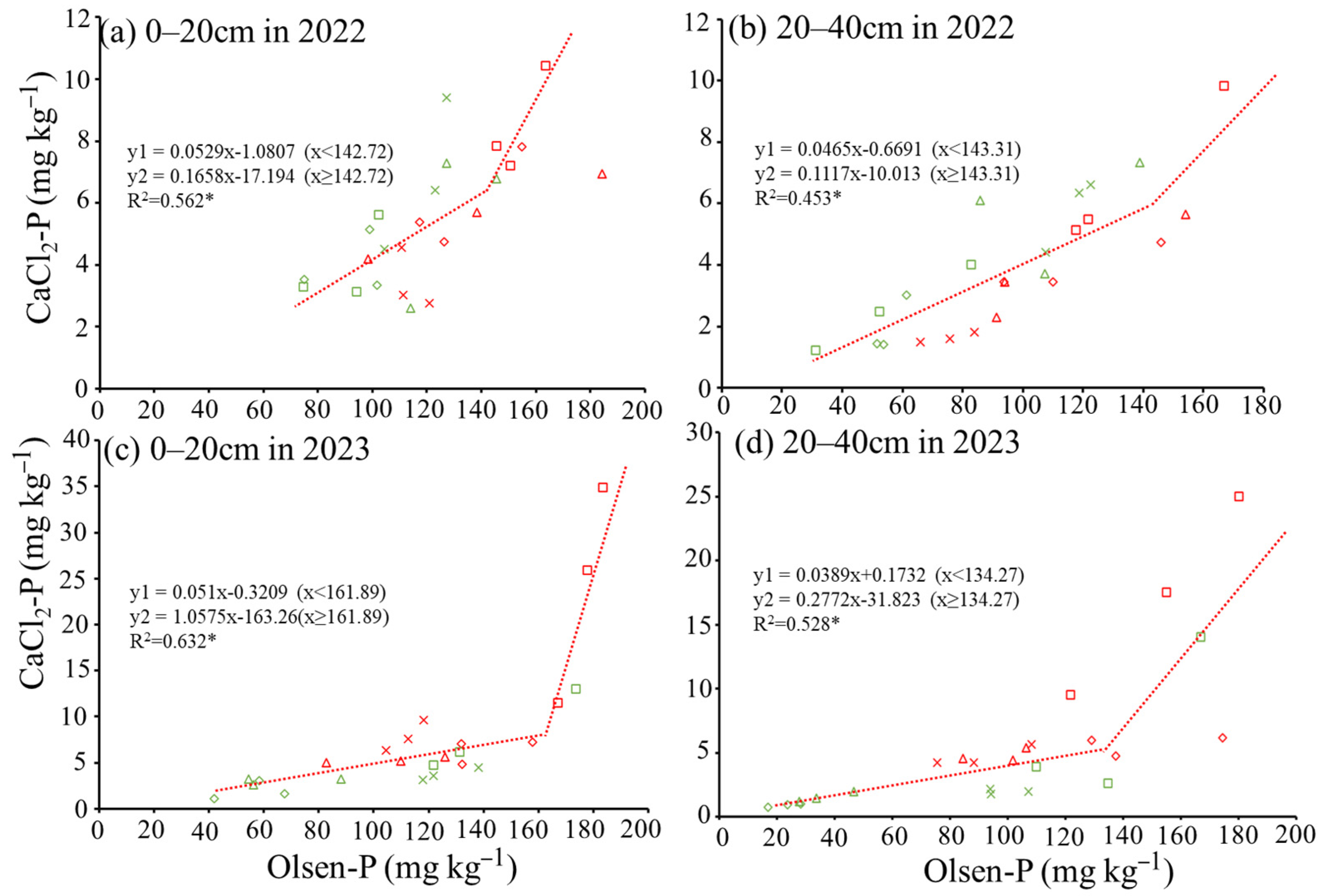
| Year | Treatment | Yield (t ha−1) | Benefit (Thousand CNY ha−1) | Soluble Solids (%) | Titratable Acids (%) | VC (mg/100 g) | Soluble Sugars (%) |
|---|---|---|---|---|---|---|---|
| 2022 | NG | 6.58 ± 1.16 b | 61.33 ± 1.86 b | 11.45 ± 0.63 a | 0.17 ± 0.05 a | 5.19 ± 1.44 a | 16.90 ± 3.17 a |
| MF | 7.55 ± 0.56 a | 69.62 ± 0.89 a | 12.00 ± 1.13 a | 0.13 ± 0.02 b | 4.47 ± 1.21 a | 16.50 ± 2.43 a | |
| 2023 | NG | 18.58 ± 2.52 b | 253.11 ± 4.04 b | 10.01 ± 0.46 a | 0.17 ± 0.11 a | 2.29 ± 0.50 b | 9.28 ± 2.14 a |
| MF | 21.49 ± 23.08 a | 292.65 ± 49.08 a | 10.80 ± 0.70 a | 0.09 ± 0.01 b | 2.77 ± 0.58 a | 8.90 ± 2.59 a |
| Depth | Indicators | pH | SOC | AN | AK | TP | Olsen-P | CaCl2-P |
|---|---|---|---|---|---|---|---|---|
| 0–20 cm | Treatment (T) | 0.28 | 0.68 | 0.06 | 0.00 | 0.05 | 0.00 | 0.00 |
| Year (Y) | 0.07 | 0.49 | 0.62 | 0.53 | 0.41 | 0.19 | 0.93 | |
| Growth Period (G) | 0.00 | 0.00 | 0.01 | 0.00 | 0.07 | 0.00 | 0.00 | |
| T × Y | 0.00 | 0.20 | 0.92 | 0.39 | 0.88 | 0.18 | 0.24 | |
| T × G | 0.19 | 0.57 | 0.00 | 0.00 | 0.00 | 0.00 | 0.00 | |
| Y × G | 0.00 | 0.27 | 0.52 | 0.01 | 0.72 | 0.04 | 0.01 | |
| T × Y × G | 0.19 | 0.99 | 0.62 | 0.21 | 0.57 | 0.99 | 0.88 | |
| 20–40 cm | Treatment (T) | 0.01 | 0.13 | 0.00 | 0.00 | 0.00 | 0.00 | 0.00 |
| Year (Y) | 0.08 | 0.07 | 0.07 | 0.66 | 0.18 | 0.10 | 0.01 | |
| Growth Period (G) | 0.00 | 0.00 | 0.00 | 0.01 | 0.04 | 0.03 | 0.00 | |
| T × Y | 0.17 | 0.02 | 0.00 | 0.32 | 0.65 | 0.02 | 0.00 | |
| T × G | 0.04 | 0.25 | 0.00 | 0.04 | 0.03 | 0.00 | 0.00 | |
| Y × G | 0.19 | 0.80 | 0.68 | 0.01 | 0.74 | 0.01 | 0.00 | |
| T × Y × G | 0.50 | 0.80 | 0.05 | 0.15 | 0.38 | 0.04 | 0.00 |
| Year | Depth | Rank | Yield | AC | ||||
|---|---|---|---|---|---|---|---|---|
| Variable | %IncMse | Varex (%) | Variable | %IncMse | Varex (%) | |||
| 2022 | 0–20 cm | 1 | AK | 6.63 | 15.8 | Intermediate P | 6.72 | 17.2 |
| 2 | Residual-Pt | 5.32 | NaOH-Pi | 5.07 | ||||
| 3 | Intermediate P | 4.75 | Residual-Pt | 3.77 | ||||
| 20–40 cm | 1 | AK | 6.33 | 16.73 | NaOH-Pi | 7.08 | 9.24 | |
| 2 | C.HCl-Po | 5.44 | NaOH-Po | 3.56 | ||||
| 3 | NaOH-Po | 4.50 | AK | 3.52 | ||||
| 2023 | 0–20 cm | 1 | NaHCO3-Pi | 9.77 | 42.35 | Labile P | 9.58 | 78.92 |
| 2 | Labile P | 8.09 | NaHCO3-Pi | 9.95 | ||||
| 3 | NaOH-Pi | 7.22 | NaOH-Pi | 8.52 | ||||
| 20–40 cm | 1 | Labile P | 8.58 | 34.05 | Labile P | 10.11 | 68.12 | |
| 2 | NaHCO3-Pi | 7.88 | NaHCO3-Pi | 10.40 | ||||
| 3 | Intermediate P | 6.24 | Intermediate P | 8.64 | ||||
Disclaimer/Publisher’s Note: The statements, opinions and data contained in all publications are solely those of the individual author(s) and contributor(s) and not of MDPI and/or the editor(s). MDPI and/or the editor(s) disclaim responsibility for any injury to people or property resulting from any ideas, methods, instructions or products referred to in the content. |
© 2025 by the authors. Licensee MDPI, Basel, Switzerland. This article is an open access article distributed under the terms and conditions of the Creative Commons Attribution (CC BY) license (https://creativecommons.org/licenses/by/4.0/).
Share and Cite
Fu, H.; Ma, Q.; Chen, H.; Wu, L.; Ye, Y. Mitigating Soil Phosphorus Leaching Risk and Improving Pear Production Through Planting and Mowing Ryegrass Mode. Agronomy 2025, 15, 1296. https://doi.org/10.3390/agronomy15061296
Fu H, Ma Q, Chen H, Wu L, Ye Y. Mitigating Soil Phosphorus Leaching Risk and Improving Pear Production Through Planting and Mowing Ryegrass Mode. Agronomy. 2025; 15(6):1296. https://doi.org/10.3390/agronomy15061296
Chicago/Turabian StyleFu, Haoran, Qingxu Ma, Hong Chen, Lianghuan Wu, and Yanmei Ye. 2025. "Mitigating Soil Phosphorus Leaching Risk and Improving Pear Production Through Planting and Mowing Ryegrass Mode" Agronomy 15, no. 6: 1296. https://doi.org/10.3390/agronomy15061296
APA StyleFu, H., Ma, Q., Chen, H., Wu, L., & Ye, Y. (2025). Mitigating Soil Phosphorus Leaching Risk and Improving Pear Production Through Planting and Mowing Ryegrass Mode. Agronomy, 15(6), 1296. https://doi.org/10.3390/agronomy15061296






